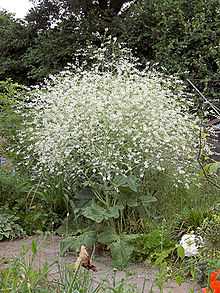Crambe cordifolia
| Crambe cordifolia | |
|---|---|
 | |
| Scientific classification | |
| Kingdom: | Plantae |
| (unranked): | Angiosperms |
| (unranked): | Eudicots |
| (unranked): | Rosids |
| Order: | Brassicales |
| Family: | Brassicaceae |
| Genus: | Crambe |
| Species: | C. cordifolia |
| Binomial name | |
| Crambe cordifolia Stev. | |
Crambe cordifolia, syn. Crambe glabrata DC. (greater sea-kale,[1] colewort, heartleaf crambe) is a species of flowering plant in the family Brassicaceae, native to the Caucasus. Growing to 2.5 m (8 ft) tall by 1.5 m (5 ft) broad, it is a substantial clump-forming herbaceous perennial with kidney-shaped dark green leaves, 35 cm (14 in) or more in length, which die down in mid- to late summer.[2] It is widely cultivated in gardens for its foliage and spectacular multi-branched inflorescences of many small, white, cruciform (cross-shaped) flowers, reaching up to 2 metres (6 ft 7 in) high and appearing in early summer.
It has gained the Royal Horticultural Society's Award of Garden Merit.[3]
The Latin specific epithet cordifolia, meaning "heart-shaped", refers to the leaves.[4]
References
- ↑ "BSBI List 2007" (xls). Botanical Society of Britain and Ireland. Retrieved 2014-10-17.
- ↑ RHS A-Z encyclopedia of garden plants. United Kingdom: Dorling Kindersley. 2008. p. 1136. ISBN 1405332964.
- ↑ "RHS Plant Selector - Crambe cordifolia". Retrieved 20 July 2013.
- ↑ Harrison, Lorraine (2012). RHS Latin for gardeners. United Kingdom: Mitchell Beazley. p. 224. ISBN 9781845337315.
- Alfred Pink. Gardening for the Million.